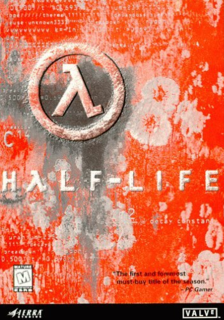Half-Life is a game that defined and revolutionnized the first person shooter genre.
But back in 1998, when the FPS genre was in full swing and continually thriving, one game came out and made history with it's inventive storyline and immersive environments.
Half-Life, from Valve Software, was that game. It broke the Doom-esque mold of FPS with it's innovative gameplay and originality. Some would even say that it was a little bit ahead of it's time, but gamers never complained one second about that fact.
In Half-Life, you play as Gordon Freeman: a nerdy, glasses wearing scientist. Freeman is hired by the Black Mesa Research Facility to conduct some mysterious experiments. Of course, when you do mysterious experiments like these, something is bound to go wrong... right? Gordon soon finds out this harsh reality when he comes face to face with hellish creatures and a man that seems to know a lot about him... even though they (supposedly) have never met.
The story in this game goes from weird to... really weird as you make your way through it. The way the story is presented is absolutely amazing. You actually have no "levels" here. I would simply call them "acts" or "episodes", each with their own beginning and end, but all of them tied in so seamlessly that it feels like one big play, if you will. This all makes the gameplay even more fun and enthralling: You are hooked from the opening scene and stay hooked throughout.
Another remarkable aspect of the gameplay and story is that you actually "feel" like you're in danger, mainly because Gordon Freeman isn't a beefed up hero like the other shooters back then He's a simple scientist who was thrust into this hellish situation without warning and much to his regret.
Everywhere Gordon goes, all hell is breaking loose. He can't escape it, so he must stand and fight against it. You'll often feel overwhelmed while being in Freeman's shoes, and that's what makes this game's horror and environments believable.
Unlike other shooters where health packs and armor are abundant, Half-Life keeps you on your toes. Gordon is equipped with a Hazard Suit, which actually represents the health in this game, and for which he must keep replenished by finding some power stations and "plugging in"... bad news is, almost all of the time, those power stations are located in an area where enemies are abundant.
Armor and ammo for your guns are pretty easy to come by at the beginning of the game, but the more you venture into Black Mesa, the more you'll need to be stingy on the way you use it.
There are also a couple of puzzles you'll have to solve while making your way across the facility. None of them are boring or seem useless, but some of them can be frustrating at times.
The areas in the game are very well designed and rarely get monotonous. You'll find yourself underground, in creepy hallways, in huge reactors, outside... and all of these are masterfully rendered.
The monsters and enemies in the game are some of the most memorable ever. Their artificial intelligence was remarkable for a game of it's time. Enemy soldiers wouldn't follow you when you fled and hid somewhere, they'd simply throw grenades at you to flush you out. Amongst the enemies hunting Gordon, who can forget the Headcrabs? Or the mysterious and notorious G-Man?
The weapons are also amazing, both in their look and sound. From the combat shotgun to the particle accelerator... oh, and your trusty crowbar, which pretty much becomes a character of it's own.
The graphics are astounding for a game released in the late 90's. The environments, enemies, guns, characters... they all look awesome.
The sound is also excellent, from the guns firing to the monsters screeching and howling, everything is done with one objective in mind: scare the living hell out of you.
Half-Life set itself apart from other shooters because of it's originality and uniqueness. It captivated gamers and thrust them into a world which they would never forget. In this sequel-ridden industry of today, a game like this would certainly find a niche with FPS gamers everywhere.

